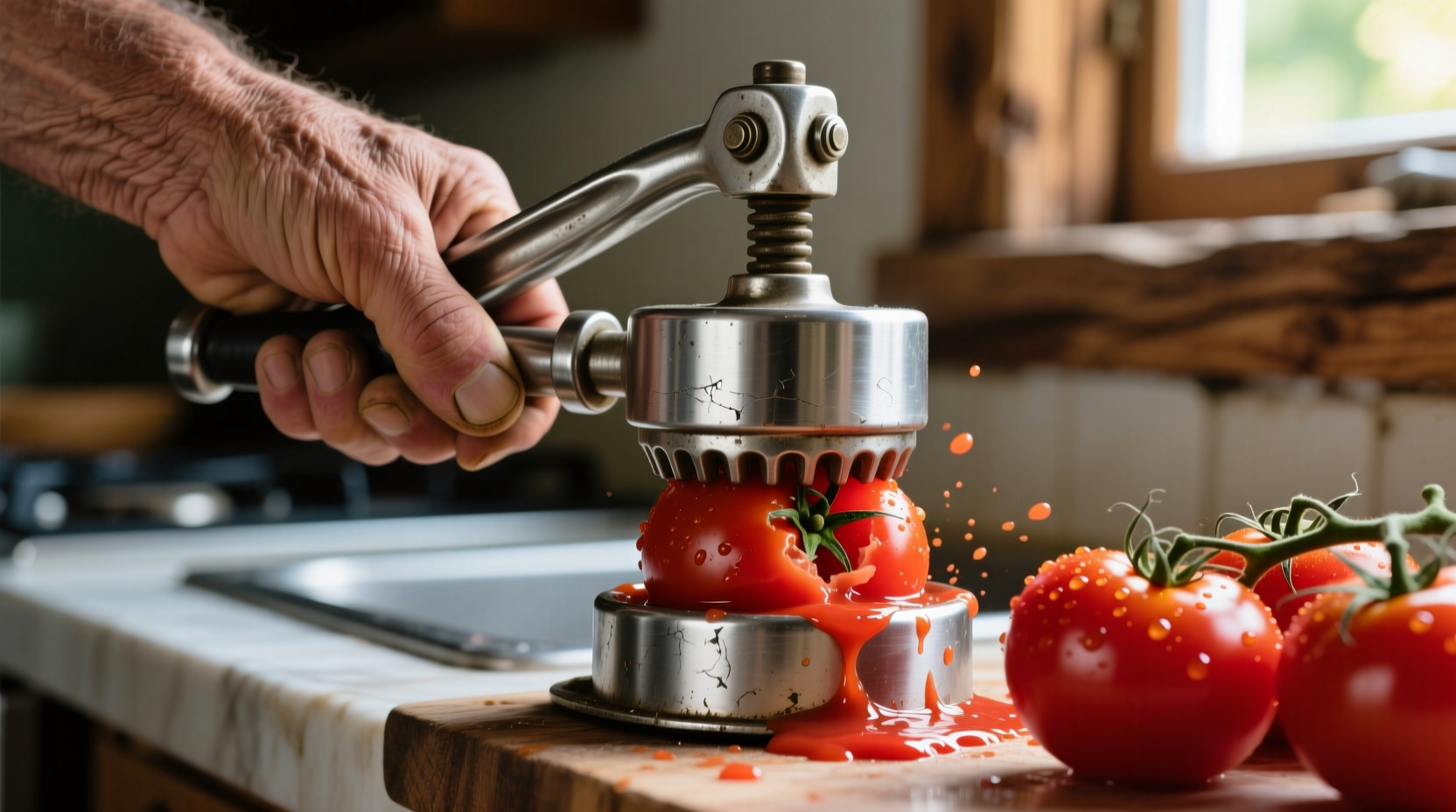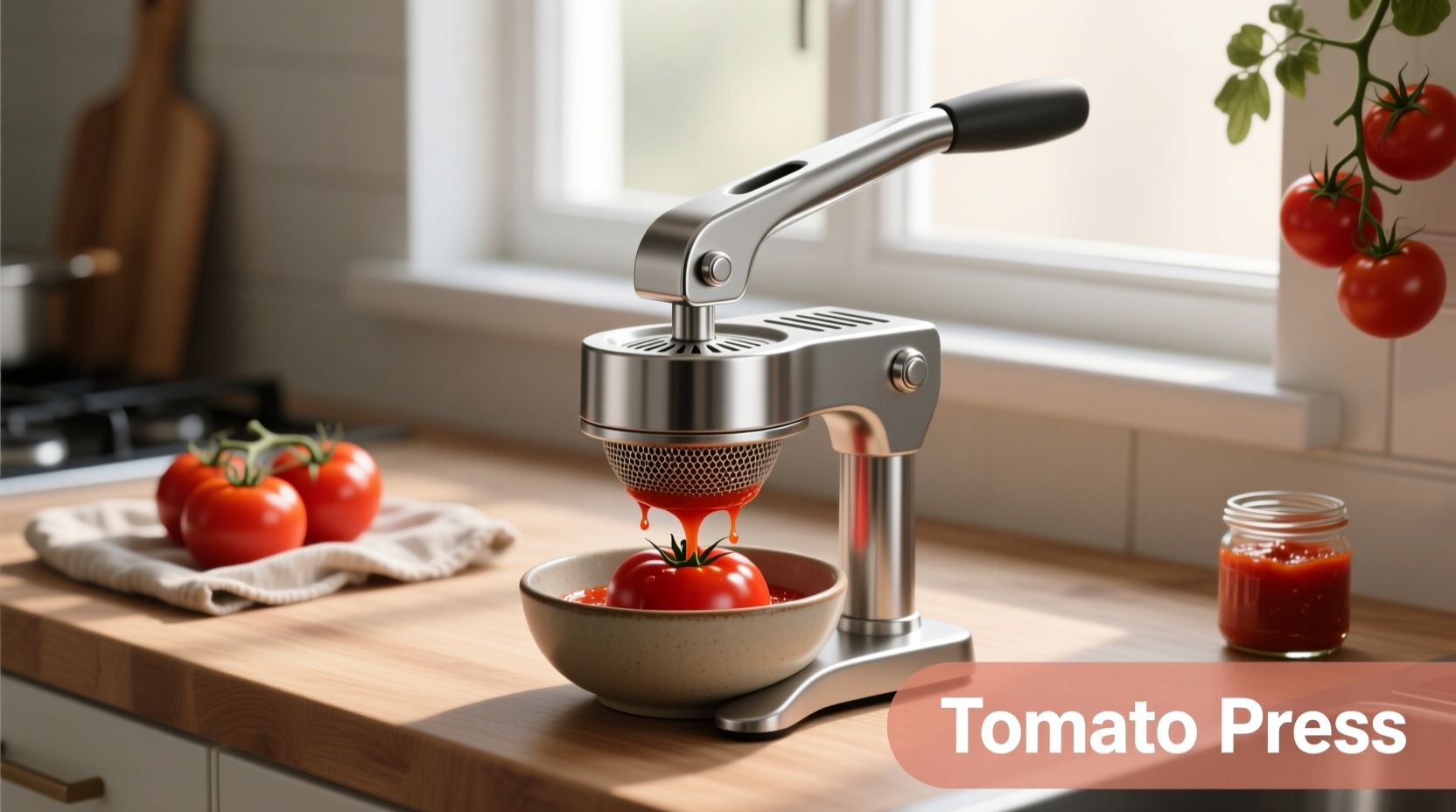A tomato press is a specialized kitchen tool designed to separate tomato pulp and juice from skins and seeds with minimal effort, preserving flavor while eliminating texture issues. This manual device works by crushing cooked tomatoes through a fine mesh screen, yielding smooth sauces, preserves, and juices without requiring electricity or generating excess heat that degrades flavor compounds. Unlike blenders or food processors that chop rather than separate, a tomato press delivers professional-quality results for canning, sauce-making, and preserving seasonal harvests.
Why Your Kitchen Needs This Timeless Tool
While modern blenders dominate many kitchens, the humble tomato press offers unique advantages that justify its place in serious cooking spaces. When processing large quantities of tomatoes—whether from your garden or a farmers' market haul—a tomato press handles the tedious separation work while you focus on flavor development. The physics behind its operation creates superior texture: pressing rather than blending prevents emulsification of seed oils that can create bitterness in sauces.
According to the National Center for Home Food Preservation, properly processed tomatoes maintain higher levels of lycopene—the antioxidant responsible for tomatoes' health benefits—when processed below 180°F. A manual tomato press operates at room temperature, preserving these valuable compounds better than thermal methods.
How Tomato Presses Have Evolved: From Farmhouse Essential to Modern Kitchen
The basic design of the tomato press has remained remarkably consistent since its introduction in the early 20th century. Originally crafted from cast iron for farmhouse kitchens, modern versions use food-grade stainless steel and aluminum for lighter weight and easier cleaning. The traditional "Italian-style" press with its distinctive hopper and crank mechanism remains popular, while newer designs incorporate features like adjustable pulp settings and dishwasher-safe components.
| Era | Materials | Key Features | Primary Users |
|---|---|---|---|
| 1920s-1940s | Cast iron, wood | Hand-cranked, single mesh size | Rural households, canneries |
| 1950s-1980s | Aluminum, chrome-plated steel | Multiple mesh options, sturdier construction | Home preservers, small farms |
| 1990s-Present | Food-grade stainless steel, BPA-free plastic | Dishwasher-safe, adjustable pulp control, compact designs | Home cooks, artisanal producers |
Mastering the Tomato Press: A Step-by-Step Guide
Using a tomato press effectively requires understanding the proper preparation sequence. Unlike electric appliances that work with raw ingredients, a tomato press needs partially cooked tomatoes for optimal results:
- Prep tomatoes: Blanch tomatoes in boiling water for 60-90 seconds, then transfer to ice water. Remove skins and roughly chop.
- Light cooking: Simmer tomatoes for 10-15 minutes until softened but not completely broken down.
- Preheat press: Run hot water through the press to warm the metal components.
- Load and press: Fill the hopper one-third full, turn the crank steadily without forcing.
- Collect products: Pulp collects in your container while skins and seeds remain in the press.

When a Tomato Press Shines: Ideal Applications
While versatile, a tomato press excels in specific culinary scenarios where texture and purity matter most:
- Preserving seasonal harvests: Process 20+ pounds of tomatoes in under an hour for canning
- Authentic Italian sauces: Create smooth marinara without seed bitterness
- Tomato juice production: Extract maximum liquid without pulp
- Salsa base preparation: Separate pulp before adding other ingredients
However, tomato presses have clear limitations. They're unsuitable for very small batches (under 2 pounds), extremely watery tomatoes, or when you specifically want seeds and skins in your final product. The University of California Cooperative Extension notes that paste tomatoes like Roma yield the best results due to their lower water content and thicker flesh.
Choosing Your Perfect Tomato Press
Selecting the right model depends on your specific needs and kitchen space:
- Capacity needs: Small (3-5 lbs) for occasional use, large (10+ lbs) for serious preserving
- Material considerations: Stainless steel offers durability but costs more; aluminum provides good value
- Storage space: Countertop models versus wall-mounted options
- Additional features: Multiple screen options, seed collection trays, non-slip bases
Professional chefs at the Culinary Institute of America recommend testing the crank mechanism before purchasing—smooth, consistent rotation without binding indicates quality construction. Avoid models with plastic gears that may wear prematurely with regular use.
Avoiding Common Tomato Press Mistakes
Even experienced cooks encounter these frequent issues:
- Overfilling the hopper: Causes inconsistent pressing and potential jamming
- Using undercooked tomatoes: Results in incomplete separation and wasted product
- Forcing the crank: Can damage gears and create uneven pressure
- Neglecting immediate cleaning: Dried tomato residue becomes difficult to remove
For optimal performance, process tomatoes while they're still warm but not scalding hot. If your press becomes difficult to turn, stop immediately—forcing it can damage internal components. Disassemble and check for blockages before continuing.
Making the Most of Your Harvest
A tomato press transforms seasonal abundance into year-round culinary enjoyment. By separating pulp from unwanted elements efficiently, it preserves the bright, fresh flavor of peak-season tomatoes better than alternative methods. Whether you're processing your first garden harvest or continuing a family preserving tradition, understanding this simple tool's capabilities helps you create superior sauces, soups, and preserves with minimal effort and maximum flavor retention.











 浙公网安备
33010002000092号
浙公网安备
33010002000092号 浙B2-20120091-4
浙B2-20120091-4